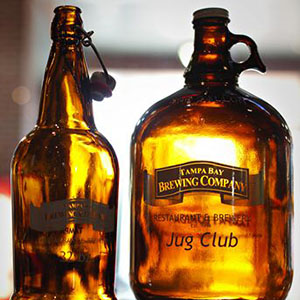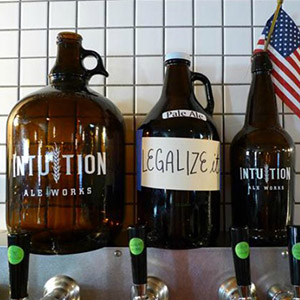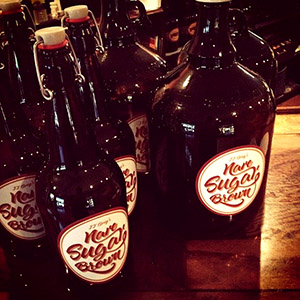 Are you a native born and raised beer drinking of the state of Florida? If so, our wonky and sometimes baffling alcohol laws are the norm to you. But if not, then the mere fact that you can’t use any of your industry standard beer growlers at breweries in our state is an oddity and an inconvenience. Yes, the standard in 47 other states does not hold sway in ours.
Are you a native born and raised beer drinking of the state of Florida? If so, our wonky and sometimes baffling alcohol laws are the norm to you. But if not, then the mere fact that you can’t use any of your industry standard beer growlers at breweries in our state is an oddity and an inconvenience. Yes, the standard in 47 other states does not hold sway in ours.
But does it make any sense?
We have to go back a few years for a short history lesson. For a long time, up until 2001, Floridians couldn’t purchase beer packaged in 750ml wine bottle sized containers, nor the 22 ounce ‘bomber’ bottles used by many craft breweries for small batch runs of beer. After a bill passed in the Florida legislature, everything under 32 ounces was legal, with an inclusion of 128 ounces… but nothing in between. What’s happened since is a long-standing tug-of-war with lawmakers to ‘make like everyone else’ and allow the half gallon growlers.
So what is a growler? The federal Alcohol and Tobacco Tax and Trade Bureau (known shorthand as the TTB) states that “a growler is a large glass when a consumer uses the container to make a purchase and the brewer then fills the container. Consumers may furnish their own growler or may purchase it from the brewer.” They are basically reusable bottles (environmental!) that are filled at the tap, letting patrons bring draft beer home with them. It’s especially awesome for people who find local beers that aren’t canned or bottled.
 The most recent legislation allowing 64-ounce growlers was filed last year, but did not pass its assigned committees in any of the state’s legislatures. It was opposed by The Florida Beer Wholesalers Association, which represents 24 distributors across the state. Their executive director, Mitch Rubin, argued the law would be at odds with the state’s current framework used to regulate craft brewers. “How do you maintain a system when everybody gets to do whatever they want?”
The most recent legislation allowing 64-ounce growlers was filed last year, but did not pass its assigned committees in any of the state’s legislatures. It was opposed by The Florida Beer Wholesalers Association, which represents 24 distributors across the state. Their executive director, Mitch Rubin, argued the law would be at odds with the state’s current framework used to regulate craft brewers. “How do you maintain a system when everybody gets to do whatever they want?”
Rubin represents fervent supporters of a strict interpretation of the three-tier system, a generally helpful anti-monopoly system of producers, wholesalers, and retailers. For small breweries, it can be a godsend to have the reach that supportive distributors have. At the other end of the spectrum, however, are distributors who want to make sure they have the full ultimate power to decide what goes where and for how much. These are the people who use the growler laws as a bargaining chip.
Funky Buddha Brewery’s head brewer Ryan Sentz sees this growler issue as more of an inconvenience to his customers than anything else. “I don’t think the 64 ounce growler law affects us as much as the consumer. We are still able to still able to sell 32oz and gallons, which people continue to do.
“Ultimately, 64 ounce growlers are the industry standard, so more people produce them and in turn bring the cost down to purchase, which would be great. Also, a lot of the carriers and bags for growlers are made for 64 ounce growlers, which would be nice to offer our customers.
 Jonathan Wakefield, whose J. Wakefield Brewery in Miami is close to completion in May, thinks that these growler size issues are causing more trouble than they may be worth.
Jonathan Wakefield, whose J. Wakefield Brewery in Miami is close to completion in May, thinks that these growler size issues are causing more trouble than they may be worth.
“We’re one of the only states that doesn’t have the 64 ounce growler. At this point, the way it’s going, it seems that pushing for 64 ounces has stirred up the hornets nest. It really shouldn’t be that big of a deal to go after; it’s another form of glassware. It wouldn’t increase our market share by that much, but [the lobbyists] have pushed back and have thrown these other things on the plate to make it worse, not better.”
Those ‘other things’ are the contents of various bills in both the Florida House and Senate that would prevent breweries from selling directly to consumers without every beer going through the hands of a distributor, the arbitrary restriction on sales of collaboration beers to 30% of annual sales, and the removal of guest taps from a brewery’s tap room.
“I couldn’t care less for 64,” Wakefield laments. “If it brings all these other implications, who gives a crap? We could go without it. Sell [the customer] two 32 ounce growlers… make the best of your situation.”
As Florida’s craft beer scene continues to expand, the struggle for the 64 ounce growler will continue. Maybe one day we’ll finally figure it out.
-Doug Fairall











